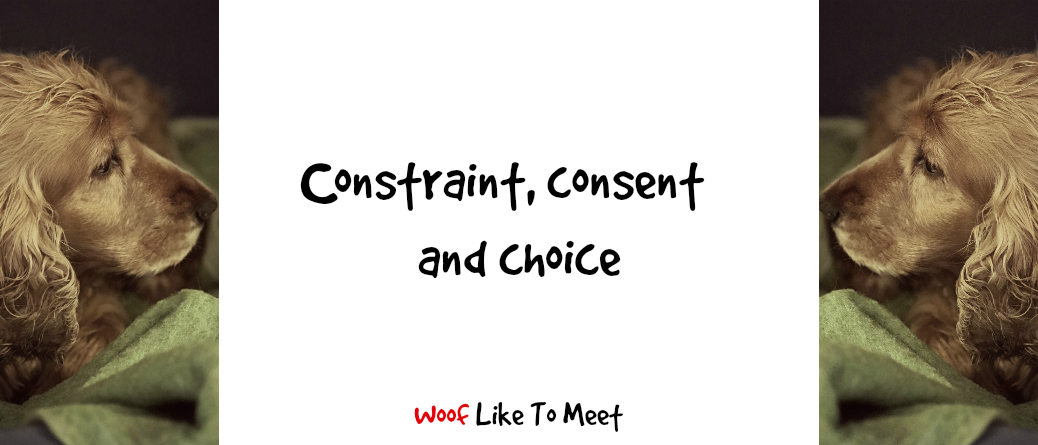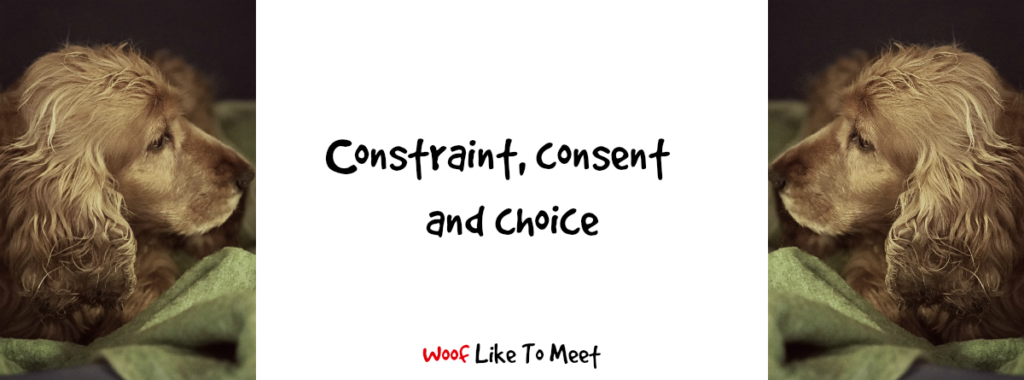
I’d like you to meet Amigo, if you’ve never met him before.
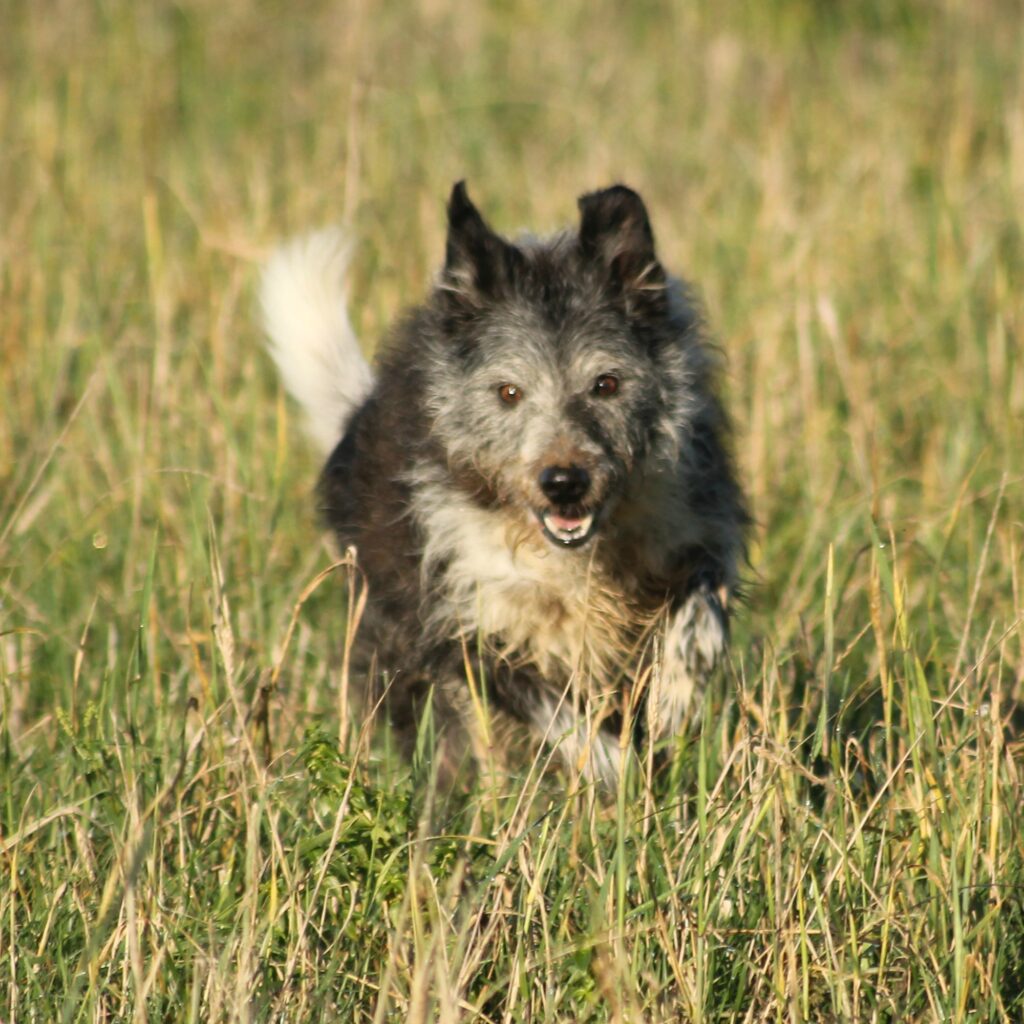
I adopted him in 2014, and he was part of my life for a very wonderful 4 years. He came in through the pound, I fell in love immediately (he was truly my heart dog) and I adopted him as soon as I could.
In 2017, he had a stroke and the remaining 14 months or so were spent in a fog of canine cognitive dysfunction. He never regained his hearing, and he was rarely truly comfortable after this, particularly at night.
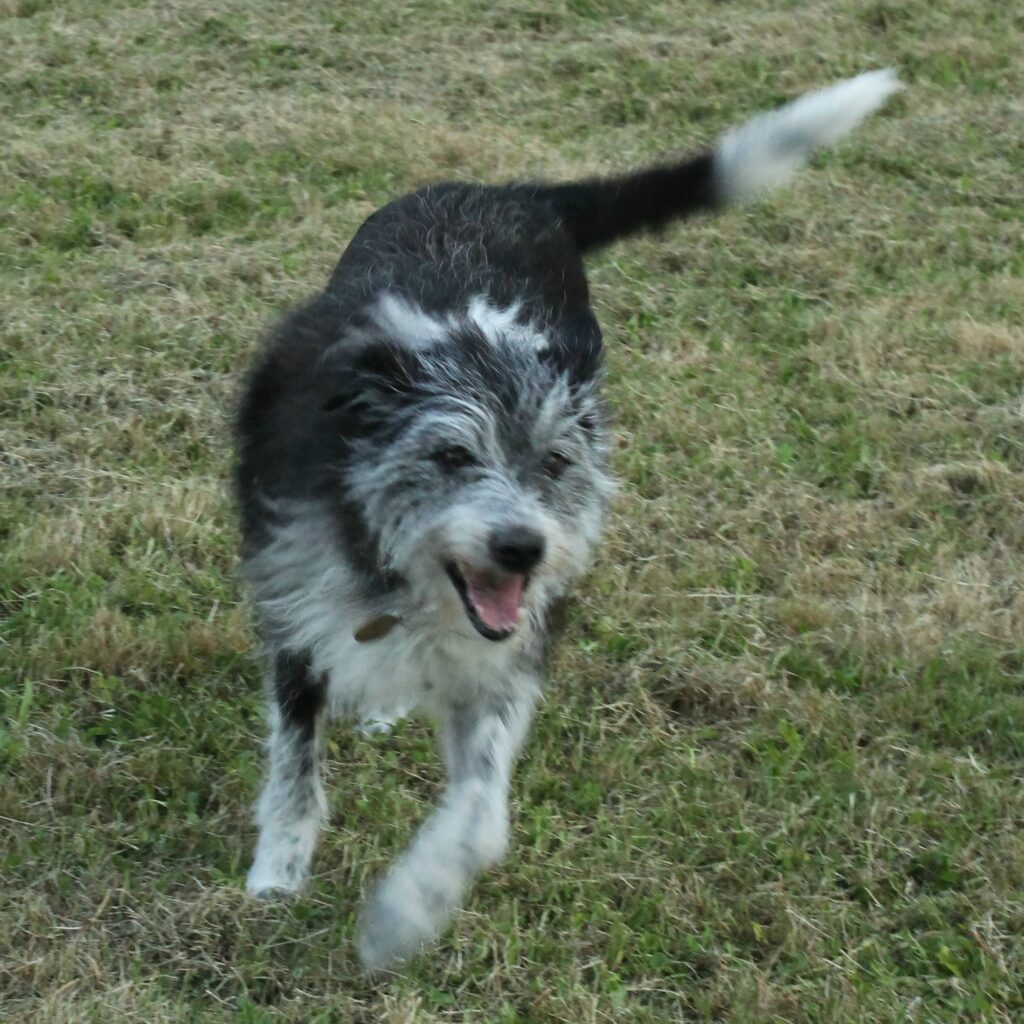
I can’t tell you what a gentle soul he was. He was never a dog’s dog, but the couple of scraps he had never involved teeth.
The last thing I expected was for Amigo, my lovely, gentle, sweet dog, to bite me in the middle of the night.
He was quite often a midnight wanderer and it would disturb the others. They’d grrr-grrrr and Amigo blithely walked all over them, got in their beds when the resident dog was already in it. Once, he was getting himself ready to go and invade Heston’s very quiet spot and I could tell it would be a fight if I didn’t intervene.
But you can’t call a deaf dog who’s disoriented anyway.
So I grabbed his collar.
And he bit my hand.
Not hard, but enough to say, “don’t grab me!”
It was the only time he bit me.
In the past, we’d have perhaps had a more extreme reaction. Indeed, many of my clients whose dogs have bitten think that the dog can’t be trusted, can’t be with children, should be muzzled… and sometimes they’re right. For some, it’s a red line and no matter how hard the contact, the dog is euthanised. For many of my clients, it can often be the one behaviour that drives them to call me.
When I do an diagnostic interview for post-bite behaviour consultations – which makes up about 70% of my work – I want to know the context, the circumstances, the triggers, the consequences and the underlying emotions. Mills and Westgarth (2017) say similar things in Dog Bites: A Multidisciplinary Approach. Each bite will be different, and often driven by different emotions. Other trainers might like to put a label on the bite as this kind of aggression or that kind of aggression, but I’m not such a fan of doing so.
In one famous study, veterinary behaviourist Dr Ilana Reisner found 27 labels in use for aggression, some of which were used to label dogs. Many were based on late 1960s work on aggression in humans. Many behaviourists have tried to categorise aggression with constructs like dominance, possessive aggression, predatory aggression and fear aggression. These terms are quite often meaningless. One term that did not come up in Dr Reisner’s review, though, and yet is frequently used by French veterinarians is irritation. In French, irritation is not emotional irritation like I might have with my brother if he keeps poking me, but physical irritation, like sunburn or itches or pain. I know some people might call this defensive aggression but for me, that’s really not the same.
Now I said before all bites are different, and that’s the principal I work off. But quite a few happen in very similar circumstances. For that reason, I do actually like this term as it describes a number of bites dogs I’ve worked with have presented with. Including Amigo. Often these bites may seem to come “out of the blue” since it may happen really fast but they’re ALWAYS preceded by a grabby human hand in close proximity. By and large, many of the bites vets sustain would probably come into this category. Pound workers are another group of people who may find themselves bitten in such circumstances, especially if the animal is already afraid or trapped. Also dog groomers. Nobody said Fido was willing to have a buzzcut. The purpose of the bite is a cease-and-desist warning to the hand.
But how do we react to such bites? Many of my clients ask me what they should do next time.
What did I do when my Meegie bit me? Was it the end of our relationship? Had he destroyed all my trust in him? What would I do next time?
I told myself there would be no next time.
That’s not to say it was his final warning and it was curtains for Meegie if he bit me again.
It’s to say that I told myself not to grab an old, deaf dog by the collar when it is dark and he is disoriented. I mean I know I’m only human and I was sleep deprived and I trusted Amigo as he’d never bitten me before. But even so.
I said he would never again be put into the position where he would need to bite me. I said sorry and said I’d do better.
I set up x-pens the next day and that was the end of the wandering into other dogs’ beds that had caused me to grab his collar. Sure, the other dogs had more limited roaming too – but for Effel, he stayed always in the same bed. Tilly always slept on my bed. So it really was easy to put pens around Effel’s bed, with open gates, and to block off the corner where Heston sometimes chose to sleep that he couldn’t get out of should Amigo wander into him.
Amigo still wandered, but it never again bothered my other dogs, and he was safe. No collar grabs needed.
I also realised he might not trust me very much any more, so we went back to basics. I did lots of practice grabbing his collar and giving him treats. We played games and had lots of massage sessions.
Now I’m not a dog bite apologist, going around blaming people for dogs biting. I don’t think dogs’ teeth should touch flesh full stop. But it happens. Neither am I screaming about “forcing” dogs to have haircuts and how pinning them down to look at a dewclaw is an abuse of their rights. Needs must, from time to time. I don’t advocate a totally hands-off life, as it’s not possible. Nor do I feel like we should tread on eggshells around our own dogs.
But I do know that I’m the thinking part of the human-canine partnership, and it’s up to me to sort it out, rather than it being up to the dog to tolerate things they find deeply unpleasant.
Yet it still surprises me that we know that so many of those bites are preceded by our grabby, chimpy, monkey hands, and we continue to do it anyway.
As I said, my motto is that the dog will never again be placed in a situation where they needed to use teeth. That’s what I don’t get about some people who are repeatedly bitten in the exact same situation over a number of occasions.
“My God! My dog bit me again!”
“What were you doing?”
“Well, exactly the same thing I was doing last time!”
Insanity: repeating the same behaviour and expecting different results. Newsflash, people. YOU are the one with the super-size neocortex and rational decision-making skills. Not your dog. Don’t expect them to change if you won’t.
For me, the first thing to check out any health issues. I appreciate this will be with another grabby monkey in a turquoise smock. You may need to do some work before you get there, or make really, really sure your vet is not a grabby monkey. None of my vets are, which is why I like them.
Underlying pain is such a huge factor in a sudden dislike of manipulation. I saw one dog a few weeks ago who didn’t like having his neck touched… vet checks are still ongoing, and it may be nothing, but the vet also felt it necessary to shuffle the dog up the line to a veterinary hospital. On Wednesday, one of our shelter dogs was adopted and knowing her history, lifting a 40kg dog into the back of an SUV with a high tailgate was not a risk I was willing to take given her hip dysplasia and arthritis, coupled with a history of not liking being manipulated. And our award for Most Grumbly Dog in the Vets 2019 at the shelter surely should go to ten-year-old Elzo the shih tzu who needs eye-drops twice daily and who needed three people to wrestle him into a headlock to do it. Itchy eyes, bad skin, wobbly legs… recipe for animals who decide they don’t like being touched thank you very much.
But shock can also contribute to this too. Like Amigo. And my non-grabby vet laughed so hard the other week when doing a blood draw from Heston as I was right near his face and as she was about to stick him with a great big syringe, I said “Don’t bite my face!”
She laughed, but she wasn’t at the bitey end of a big, scared dog about to get stuck with a fat syringe.
These issues can arise with grooming too. We had one beautiful Bernese mountain dog with us for months who’d been brought in with chronic ear infections and a dire need for grooming. He said no. Hence the untreated ear infection and the lack of grooming… making everything so much worse.
But it doesn’t have to be like this.
I’m not a fan of wild animals in facilities, but I know there are such things, so if there are, I’d prefer to do things kindly.
What they don’t tell you is that many animals in experimentation are trained to present body parts for blood draws, for cables to be attached or restraints to be applied. Madness. If we take one thing from this, it’s that even in the world of animal testing, they’re not wrestling dogs to the floor and using four people to hold the animal down.
Zoos also picked up on this trend:
Now I’m not a fan of zoos for many reasons but this did make me think how much easier it would have been to have had my cat do this rather than having to trick him, ball him up in a towel and hope none of my scratches went septic. Can you even do that with a tiger?
And when you can’t, that’s when sedatives come in. But that isn’t a good thing and it can really interfere with your health checks, particularly if the animal has heart problems.
We spend so much time thinking it’s our right as animal guardians to wrestle our “stubborn” companions onto vet tables or at the groomers, or drug them, that I think we get a little trapped in that. It doesn’t cross our tiny minds to teach our dogs the same stuff that animals are taught in zoos or labs. I mean they’re our dogs, right?
But it doesn’t take much to build up a ‘yeah, I’m not such a fan, Sharon, so I’m sitting this one out!’ from your “stubborn” dog when grooming, handling or putting on harnesses even. Certainly when attaching leads or putting on collars, securing in vehicles or lifting dogs up and down. Then we think there’s something wrong with our “aggressive” dog. Trouble is, the bite usually works to stop the irritating thing (you) and that’s NOT a good thing for a dog to learn…. because, as we know, DOGS DO WHAT WORKS. So says Jean Donaldson. And she’s right. Dogs who’ve bitten when a hand approached are likely to do the same again if it stopped the hand doing stuff to them. These bites, by and large, are often bites to the hand. But I’ve seen bites to the face for people who were crowding their dogs.
Dogs are quick to work out what hurts and to find ways to stop it. I caught a moment of this the other week. Lidy, my reprobate malinois, got her lip caught by a dog a few months back. It bled profusely and the skin is still a bit delicate. I was doing a video for a client about how to get her to approach the brush. Things were great through seven trials. Then she just stopped. Stopped looking at the brush, wouldn’t orient towards it.
I was a bit stumped. I let her finish the remnants of the treats thinking we needed to refresh our training, and only then did I see she’d caught her lip on the brush and it was bleeding a little.
She is such an obedient and operant girl – she loves learning. She does practically everything I asked, and she played dumb.
“Bumped brush, brush hurt, won’t look at brush…”
Can you see why a more sensitive dog might quickly build up a link between you and the tools you like to use to hurt them with?
This is worsened by one of the most controversial behaviours in dog training (and most abusive – let’s start from there) that has been sadly popularised by barbaric trainers and by TV programmes. The Alpha Roll. You know, force your dog to submit and pin him to the floor.
This “technique” was dreamed up by the Monks of New Skete (actual monks, not some name for a family of expert dog trainers, just in case you thought they might know about dogs rather than gods) who popularised it, passed it on to Cesar Millan …. and then …. retracted their guidance. They said it was too complex for most people to do and it could backfire. Bless ’em. The general population are just too crap at wrestling dogs into submission. Sure it could backfire. This Alpha Rolling or forced submission is behind so many irritation bites I can’t even begin to tell you.
Forcing dogs into grooming, handling or veterinary care causes such a breakdown of trust that it can be impossible to overcome completely. And yes, you might be able to force the dog once. But woe betide you the next time. It kind of made me laugh to see on one dog’s vet notes that the first time the dog was presented, the vet thought there was a suspicion of hip dysplasia and was able to manipulate the dog. Strangely, yes, strangely, and he’d written that word on the notes, the second time the dog went back, she was too aggressive to be manipulated. Fool me once, shame on you. Fool me twice? Don’t think so.
Some dogs will submit and will seem to tolerate it. I say “seem” and that’s important.
In the late 60s and early 70s, a psychology professor named Martin Seligman did some studies on a concept called learned helplessness. It informed us why people sometimes don’t act to change things when they can, or why they tolerate the intolerable. Dogs are the same. If you’re scoffing about me making anthropomorphic comparisons, you need to know he figured out human motivations using dogs. So no anthropomorphism at all.
First, he “restrained” dogs in what’s known as a Pavlovian hammock. Basically an inescapable mechanism for keeping dogs still.
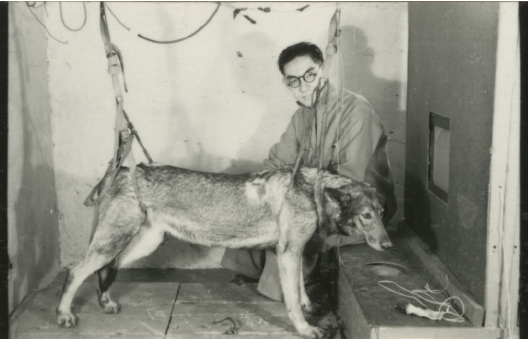
You may be disgusted and thinking ‘how inhumane!’ but if you use your hands any time to restrain your dog, no matter the circumstances, it’s not much different if you ask me. All shades of grey.
So these dogs he shocked. Because they were restrained, they couldn’t escape it.
He also used some other dogs in a different system: a shuttlebox. This has an electrified floor on one side, and an escape hatch to a no-electrified bit. They were shocked, but they learn to hop over the other side.
What he learned was dogs who’d been subject to shocks they couldn’t escape from in the past would just accept shocks and not seek to escape even if they could.
They basically just shut down completely.
Now, yes, this tells us a lot about resilience and depression and learned helplessness and why battered spouses stay in the relationship and why depressed people don’t seem to help themselves.
But it also tells us that dogs who’ve been restrained and punished may just shut down and give up.
So your pinning a dog may seem to work.
However, I’m not comfortable with that; I mean, I know in emergencies, you do what you need to – and I know I’ve had to do that sometimes, knowing what the repercussions are, just because it was medically necessary. But I’m still not comfortable with it.
I also know that such behaviours, in almost half the times it’s used, come out fighting (and biting).
It may also be that your dog will tolerate it, tolerate it, tolerate it, and then won’t.
So I don’t choose to restrain my dogs because a) if they tolerate it, it may be that they’ve just shut down, and ethically, I can’t disapprove of Seligman shocking dogs in hammocks or slings if I’m hypocritically pinning my dog to do things to them that they find offensive, and b) because one day, my dog might decide to become one of the very, very large number of dogs who become more aggressive when restrained.
Does that mean I’m just some sensitive soul who doesn’t touch my dogs or that I tread on eggshells around them?
Not at all. Just like the guy with the tiger, I know I’ll need to do some stuff to my dog that if my dog had their say, they’d say a loud “no thank you!”. You don’t have to be some kind of sensitive soul who goes through life never handling your dog. That way madness and even neglect lie. But when dogs feel they have a choice, a marvellous thing happens.
First, you don’t put your back out yoinking your dog around.
Second, your dog (because they’re dogs and dogs are great) will perform many amazing things. After all, if they can teach a tiger, you can teach your dog. My whole epiphany about animal care came from watching a walrus opening its mouth on cue. I was quite ashamed that I had to wrestle my dogs to look in their mouth.
Here’s the crucial bit…
When a dog has choice and consents willingly (be very clear about this… it is not coercion or force!) then you find they’re more relaxed, it’s less stressful and you can stop being afraid your dog will bite you.
You ask and they consent.
It really is a request, too.
The requests we make of our dogs also get easier with cold trials and repetition and practice. The more they do it, the more they say, “fine!”
It requires a change in mindset though. I was never a very grabby dog person anyway. Now I rarely grab them (if ever?) but you know, when it does, say for instance, an escaped dog at the shelter, then I know I have work to do to both practise it for next time and to smooth out the ugly fallout from having grabbed them in the first place. You know, most of the time, dogs put up with it. This morning, we had an escapee, and one of our staff had to corner him and then picked him up. But just because we may need to do it and dogs tolerate it doesn’t mean they always will. Also, what we do in emergencies is one thing; what we can plan for is another entirely.
Heston and Lidy both know “open!” to open their mouths without handling. Heston knows “show me your wiener!” which seemed like an impossibly cute trick to teach a 6 week old dog, but turned out to be a stroke of genius when the vet wanted to ogle his undercarriage. By the end of her life, Tilly rattled she had that many pills and drops, but she presented her eyes and ears willingly right up until the end. That was a long way to come for a girl who bit a vet, aged 4. Likewise Elzo, the grumpy shih tzu, who grumbles but comes to get his eyes done by his foster dad and then trots off with a treat. No fingers bitten! Heston knows “up!” to come and stand on the back of a chair for me to check for ticks. He knows “hup!” to get in the car (although he does that with any open door, cars are that much fun).
Teaching dogs “up!” and “on!” and “off!” and “down!” helps cut out so very much of the handling that ends up being classed as resource guarding or handling sensitivity.
Giving them choice about putting muzzles on or harnesses on also sets up dogs to say yes rather than no. This brings up a crucial point about Lidy, my little work-in-progress. Vets are not for her. There is no way by the time her vaccinations are due that I will have got her up to a chin rest whilst other people stick her with pointy objects. But I can make the muzzle a less unpleasant experience for her as we make steps towards cooperative care. And you know what? She may never tolerate vets. That’s fine too. She tolerates the things I need to do to her and that’s the important bit.
As you can see in the following video with the chihuahua, when the dog chooses, it stops the vicious circle of aggression and punishment. Little dogs are far more likely to have been restrained, sadly. One of the best things I ever say to my clients is to imagine how they’d do things if they had a 50kg grumbly big dog. That’s one reason I’m less of a grabber these days. When you’ve had big dogs, you do a lot of this stuff instinctively.
There are literally so many ways you can allow your dog to choose. Refusal isn’t a big deal, telling you that the dog isn’t able to handle it right now. But refusal gets less and less because, guess what, you’re not having to use force in the first place.
Whilst I’m not a fan of the Julius harness used in this video, I am certainly a fan of teaching your dog to consent to harnesses rather than have the damn thing forced on.
Two things that I find really helpful as well are teaching your dog to nose touch to hand and to rest their chin on your hand or lap. Those two behaviours can build up nicely into so many others. Using target sticks like the tiger can also help. I like my hand as I’ve always got that with me though.
The good news is that more and more vets are getting on board with fear free cooperative care, as are groomers.
If only, when I got Mr Basil back in 1997, I’d known you can clicker train cats… how different our relationship would have been. Luckily, through many people who have pioneered cooperative husbandry in companion animals, it has been the saving grace of my relationship with my dogs. That my cat was so terrified of the crate and the car need not have depended on me forcing him to comply or removing his choice.
The best thing about cooperation and choice is that your dog is much more “compliant”. The tough thing is that this doesn’t happen overnight. I do a little a day and repurposing tricks like playing dead, giving a paw or tilting their head can be really great ways to turn something terrible like tummy inspections, blood draws or ear checks into something fun.
The best things you can work on to start you off are nose-to-hand targets, chin rests and getting up and off things themselves. But there are literally so many things you can teach your dog that make vet care and grooming an absolute doddle. Start small and keep it fun, and you’ll keep building up the trust you’ll need to get your dog through the pains of old age.
Next week: how to help dogs with car journeys.

